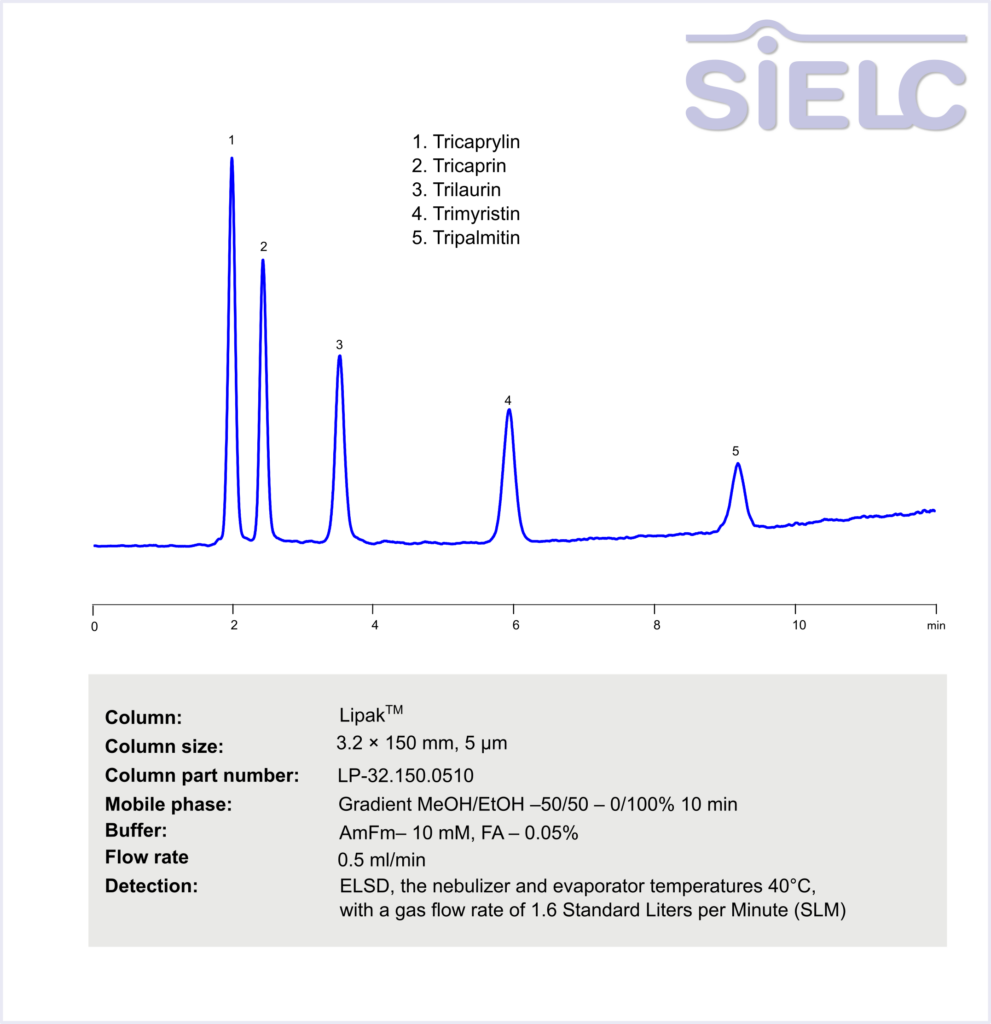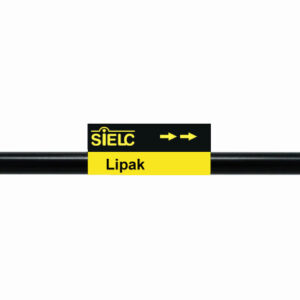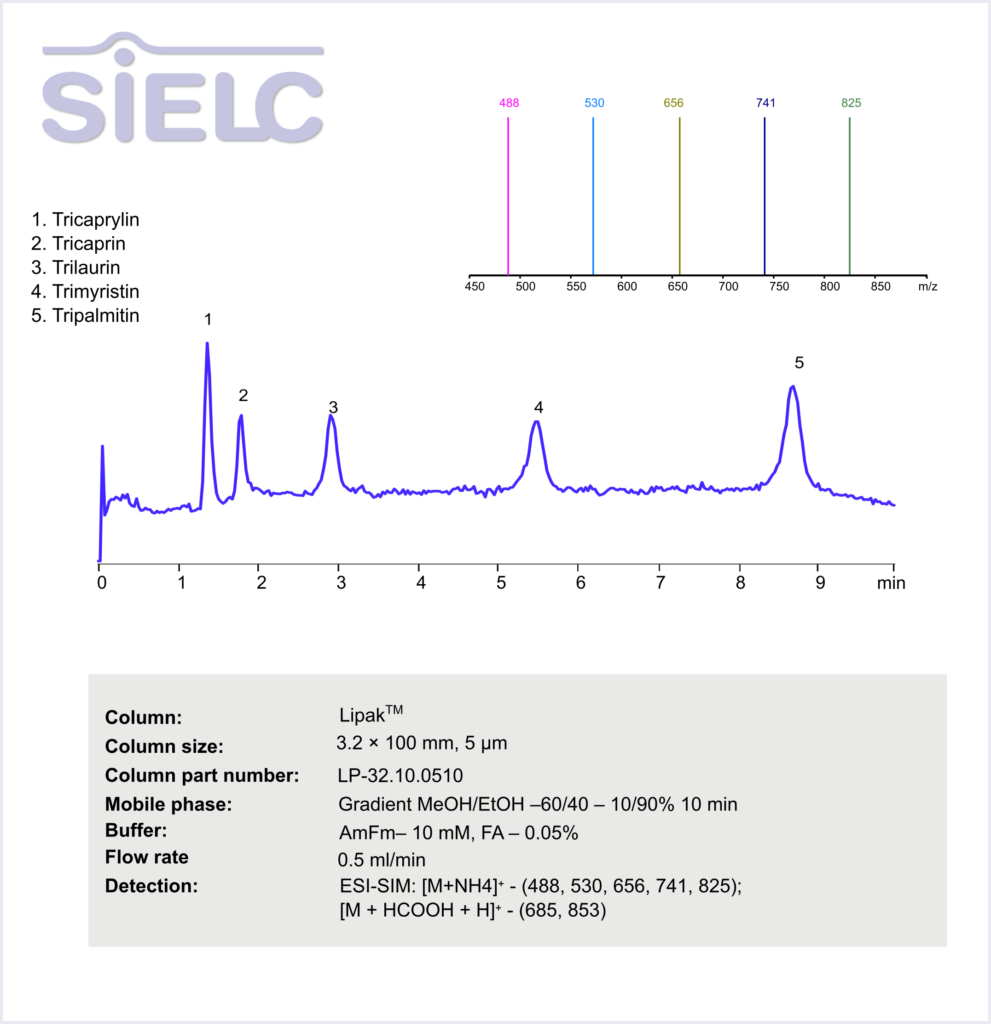
| Molecular Formula | C45H86O6 |
|---|---|
| Molecular Weight | 723.2 |
| InChI Key | DUXYWXYOBMKGIN-UHFFFAOYSA-N |
| LogP | 15.7 |
| Synonyms |
|
Applications:
HPLC-ELSD Method for Analysis of Lipid Standards: Triglyceride Mixtures on Lipak Column
March 12, 2025
HPLC Method for Tricaprylin, Tricaprin, Trilaurin, Trimyristin, Tripalmitin on Lipak by SIELC Technologies
High Performance Liquid Chromatography (HPLC) Method for Analysis of Tricaprylin, Tricaprin, Trilaurin, Trimyristin, Tripalmitin
Series of triglycerides, which are esters derived from glycerol and three fatty acids.
- Tricaprylin:
- Composed of glycerol and three caprylic acid (C8:0) molecules.
- Found in coconut oil and palm kernel oil.
- Used in cosmetics, food, and pharmaceuticals for its quick energy release.
- Tricaprin:
- Made from glycerol and three capric acid (C10:0) molecules.
- Occurs naturally in coconut oil and goat milk.
- Utilized for energy supplementation and in lipid-based formulations.
- Trilaurin:
- Formed by glycerol and three lauric acid (C12:0) molecules.
- Present in coconut and palm kernel oils.
- Known for its antimicrobial properties and use in soaps and cosmetics.
- Trimyristin:
- Consists of glycerol and three myristic acid (C14:0) molecules.
- Major component of nutmeg butter.
- Employed in the production of surfactants and as a fat source in food.
- Tripalmitin:
- Made up of glycerol and three palmitic acid (C16:0) molecules.
- Found in palm oil, cocoa butter, and animal fats.
- Used in food processing, cosmetics, and as a model lipid in research.
Tricaprylin, Tricaprin, Trilaurin, Trimyristin, Tripalmitin can be retained, and analyzed using a Lipak mixed-mode stationary phase column. The analysis utilizes an gradient method with a mobile phase consisting of methanol (MeOH), ethanol (EtOH), ammonium formate and formic acid as a buffer. Detection is achieved using ELSD.
| Column | Lipak, 3.2 x 150 mm, 5 µm, 100 A, dual ended |
| Mobile Phase | Gradient MeOH/EtOH – 50/50-0/100% in 10 min |
| Buffer | AmFm– 10 mM, FA – 0.05% |
| Flow Rate | 0.5 ml/min |
| Detection | ELSD, the nebulizer and evaporator temperatures 40°C, with a gas flow rate of 1.6 Standard Liters per Minute (SLM) |
| Class of Compounds | Lipid Standards: Triglyceride Mixtures |
| Analyzing Compounds | Tricaprylin, Tricaprin, Trilaurin, Trimyristin, Tripalmitin |
Application Column
Lipak
Column Diameter: 3.2 mm
Column Length: 150 mm
Particle Size: 5 µm
Pore Size: 100 A
Column options: dual ended
Tricaprylin
Trilaurin
Trimyristin
Tripalmitin

HPLC-MS Method for Analysis of Lipid Standards: Triglyceride Mixtures on Lipak Column
February 25, 2025
HPLC Method for Tricaprylin, Tricaprin, Trimyristin, Trilaurin, Tripalmitin on Lipak by SIELC Technologies
High Performance Liquid Chromatography (HPLC) Method for Analysis of Tricaprylin, Tricaprin, Trimyristin, Trilaurin, Tripalmitin
Series of triglycerides, which are esters derived from glycerol and three fatty acids.
- Tricaprylin:
- Composed of glycerol and three caprylic acid (C8:0) molecules.
- Found in coconut oil and palm kernel oil.
- Used in cosmetics, food, and pharmaceuticals for its quick energy release.
- Tricaprin:
- Made from glycerol and three capric acid (C10:0) molecules.
- Occurs naturally in coconut oil and goat milk.
- Utilized for energy supplementation and in lipid-based formulations.
- Trilaurin:
- Formed by glycerol and three lauric acid (C12:0) molecules.
- Present in coconut and palm kernel oils.
- Known for its antimicrobial properties and use in soaps and cosmetics.
- Trimyristin:
- Consists of glycerol and three myristic acid (C14:0) molecules.
- Major component of nutmeg butter.
- Employed in the production of surfactants and as a fat source in food.
- Tripalmitin:
- Made up of glycerol and three palmitic acid (C16:0) molecules.
- Found in palm oil, cocoa butter, and animal fats.
- Used in food processing, cosmetics, and as a model lipid in research.
Tricaprylin, Tricaprin, Trimyristin, Trilaurin, Tripalmitin can be retained, and analyzed using a Lipak mixed-mode stationary phase column. The analysis utilizes an gradient method with a mobile phase consisting of methanol (MeOH), ethanol (EtOH), ammonium formate and formic acid as a buffer. Detection is achieved using LC MS.
| Column | Lipak, 3.2 x 100 mm, 5 µm, 100 A, dual ended |
| Mobile Phase | Gradient MeOH/EtOH – 60/40-10/90% in 10 min |
| Buffer | AmFm– 10 mM, FA – 0.05% |
| Flow Rate | 0.5 ml/min |
| Detection | ESI-SIM: [M+NH4]⁺ – (488, 530, 656, 741, 825); [M + HCOOH + H]⁺ – (685, 853) |
| Class of Compounds | Lipid Standards: Triglyceride Mixtures |
| Analyzing Compounds | Tricaprylin, Tricaprin, Trimyristin, Trilaurin, Tripalmitin |
Application Column
Lipak
Column Diameter: 3.2 mm
Column Length: 100 mm
Particle Size: 5 µm
Pore Size: 100 A
Column options: dual ended
Tricaprylin
Trilaurin
Trimyristin
Tripalmitin




